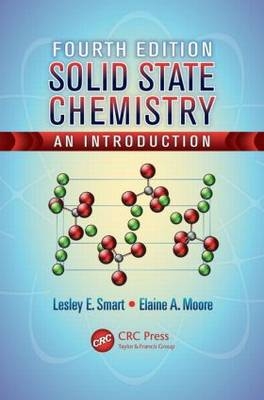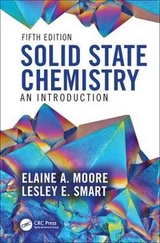
Solid State Chemistry
Crc Press Inc (Verlag)
978-1-4398-4790-9 (ISBN)
- Titel erscheint in neuer Auflage
- Artikel merken
The book covers:
A range of synthetic and physical techniques used to prepare and characterize solids
Bonding, superconductivity, and electrochemical, magnetic, optical, and conductive properties
STEM, ionic conductivity, nanotubes and related structures such as graphene, metal organic frameworks, and FeAs superconductors
Biological systems in synthesis, solid state modeling, and metamaterials
This largely nonmathematical introduction to solid state chemistry includes basic crystallography and structure determination, as well as practical examples of applications and modern developments to offer students the opportunity to apply their knowledge in real-life situations and serve them well throughout their degree course.
New in the Fourth Edition
Coverage of multiferroics, graphene, and iron-based high temperature superconductors, the techniques available with synchrotron radiation, and metal organic frameworks (MOFs)
More space devoted to electron microscopy and preparative methods
New discussion of conducting polymers in the expanded section on carbon nanoscience
Lesley Smart studied Chemistry at Southampton University, UK and after completing a Ph.D. in Raman spectroscopy, she moved to a lectureship at the (then) Royal University of Malta. After returning to the United Kingdom, she took an SRC Fellowship to Bristol University to work on X-ray crystallography. From 1977-2009 she worked at the Open University Chemistry Department as a Lecturer, Senior Lecturer and Molecular Science Programme Director, and since retiring holds an honorary senior lectureship there. At the Open University, she was involved in the production of undergraduate courses in inorganic and physical chemistry and health sciences. She was the coordinating editor and an author of The Molecular World course, a series of eight books and DVDs co-published with the Royal Society of Chemistry, authoring two of these (2002), The Third Dimension and Separation, Purification and Identification. Her most recent books are (2007) Alcohol and Human Health and (2010) Concepts in Transition Metal Chemistry. She has an entry in Mothers in Science: 64 ways to have it all (downloadable from the Royal Society website). She has served on the Council of the Royal Society of Chemistry and as the Chair of their Benevolent Fund. Her research interests are in the characterization of the solid state, and she has publications in single-crystal Raman studies, X-ray crystallography, zintl phases, pigments, and heterogeneous catalysis and fuel cells. Elaine Moore studied Chemistry as an undergraduate at Oxford University and then stayed on to complete a D.Phil in Theoretical Chemistry with Peter Atkins. After a two-year post-doctoral position at Southampton, she joined The Open University in 1975 as Course Assistant, becoming a Lecturer in Chemistry in 1977, Senior Lecturer in 1998, and Reader in 2004. She has produced OU teaching texts in Chemistry for Courses at levels 1, 2, and 3 and written texts in Astronomy at level 2 and Physics at level 3. She is co-author of Metal-Ligand Bonding, and the text Molecular Modelling and Bonding, which forms part of the OU level 2 Chemistry Course, was co-published by the Royal Society of Chemistry as part of The Molecular World series. She oversaw the introduction of multimedia into chemistry courses and has designed multimedia material at levels 1, 2 and 3. She is co-author of Metals and Life and of Concepts in Transition Metal Chemistry, which are part of a level 3 Open University Course in Inorganic Chemistry and co-published with the Royal Society of Chemistry. Her research interests are in theoretical chemistry applied to solid state systems and to NMR spectroscopy. She is author or co-author on over 50 papers in scientific journals.
An introduction to crystal structures
Introduction
Close-packing
Body-centred and primitive structures
Symmetry
Lattices and unit cells
Crystalline solids
Lattice Energy
Physical methods for characterizing solids
Introduction
X-ray Diffraction
Powder Diffraction
Single Crystal X-ray Diffraction
Neutron Diffraction
Electron Microscopy
Scanning Probe Microscopy, SPM
Atomic Force Microscopy, AFM
X-ray Absorption Spectroscopy, XAS
Solid-state Nuclear Magnetic Resonance Spectroscopy
Thermal Analysis
Temperature Programmed Reduction, TPR
Other Techniques
Synthesis of solids
Introduction
High temperature ceramic methods
Microwave synthesis
Combustion synthesis
High pressure methods
Chemical vapour deposition (CVD)
Preparing single crystals
Intercalation
Synthesis of Nanomaterials
Choosing a method
Bonding in solids and their electronic properties
Bonding in solids - free electron theory
Bonding in solids - molecular orbital theory
Semiconductors - Si and Ge
Bands in compounds - Gallium Arsenide
Bands in d-block compounds - transition metal monoxides
Classical Modelling
Defects and non-stoichiometry
Point Defects - an introduction
Defects and their concentration
Ionic conductivity in solids
Solid Electrolytes
Applications of solid electrolytes
Colour Centres
Non-stoichiometric compounds
Extended defects
Three-dimensional defects
Electronic properties of non-stoichiometric oxides
Microporous and Mesoporous solids
Zeolites
Other microporous framework structures
Mesoporous structures
New materials
Clay minerals
Optical properties of solids
Introduction
The interaction of light with atoms
Absorption and emission of radiation in continuous solids
Refraction
Photonic Crystals
Metamaterials – ‘cloaks of invisibility’
Magnetic and Electrical Properties
Introduction
Magnetic susceptibility
Paramagnetism in metal complexes
Ferromagnetic metals
Ferromagnetic compounds - chromium dioxide
Antiferromagnetism - transition metal monoxides
Ferrimagnetism - ferrites
Spiral Magnetism
Giant, Tunnelling, and Colossal Magnetoresistance
Electrical polarisation
Piezoelectric crystals
The Ferroelectric Effect
Multiferroics
Superconductivity
Introduction
Conventional superconductors
High temperature superconductors
Uses of high-temperature superconductors
Nanostructures and solids with low-dimensional properties
Nanoscience
Consequences of the nanoscale
Low-dimensional and nano-structural carbon
Carbon-based conducting polymers
Non-carbon nanoparticles
Non-carbon nanofilms and nanolayers
Non-carbon nanotubes, nanorods and nanowires
| Erscheint lt. Verlag | 29.6.2012 |
|---|---|
| Zusatzinfo | approx 142 equations; 61 Tables, black and white; 396 Illustrations, black and white |
| Verlagsort | Bosa Roca |
| Sprache | englisch |
| Maße | 156 x 235 mm |
| Gewicht | 839 g |
| Themenwelt | Naturwissenschaften ► Chemie ► Anorganische Chemie |
| Naturwissenschaften ► Chemie ► Physikalische Chemie | |
| Technik ► Maschinenbau | |
| ISBN-10 | 1-4398-4790-8 / 1439847908 |
| ISBN-13 | 978-1-4398-4790-9 / 9781439847909 |
| Zustand | Neuware |
| Informationen gemäß Produktsicherheitsverordnung (GPSR) | |
| Haben Sie eine Frage zum Produkt? |
aus dem Bereich



